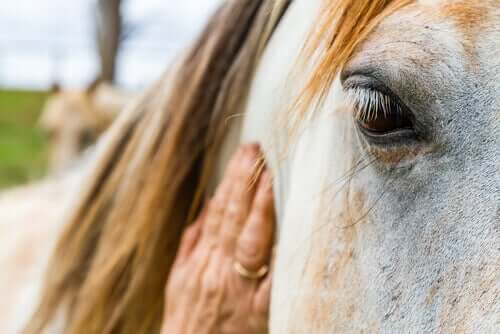The Treatment of Ringworm in Horses

Ringworm in horses is also known as equine dermatophytosis. It’s an infection of fungal origin that affects the superficial tissues of the skin and hair. The main fungi responsible for this condition are Trichophyton equinum and Trichophyton mentagrophytes.
The spread of ringworm to horses takes place through direct exposure to the fungus, common in the soil. At the same time, direct contact with sick people or animals is also a common cause of infection.
Finally, contaminated objects–especially objects used for grooming–can also be responsible for the spread of ringworm. In the paragraphs to follow, we’ll tell you more about how to care for horses with ringworm.
Diagnosis and the phases of this illness
Ringworm in horses usually appears in dead cells on the skin and scalp and form sort of circular patches prone to alopecia and peeling. The areas of greatest friction with the reins or the saddle are the most susceptible to contagion. And the infection can then spread to other areas of the body.
If you notice any of the initial symptoms–scabs, scaling or itching–you should reach out to a veterinarian. Early diagnosis involving analyzing tufts of hair near the lesion will prevent the spread of the fungus to the rest of the body. At the same time, it will reduce the risk of the infected horse spreading the fungus to other animals or humans.
Confirming ringworm in horses through positive fungal cultures is the most reliable method of diagnosis. However, this requires special laboratory equipment and a growth period of up to 10 days.
Therefore, as an alternative or complementary method, vets usually resort to the microscopic diagnosis of hairs of skin flakes in order to spread up the process. Both techniques are frequent in the confirmation of ringworm in other mammals, including humans.

As the infection develops, new symptoms will develop. These include itching and hair loss, as well as symptoms like reddening and swelling. Just the same, except in the most serious of cases, the spread of these fungal lesions will not affect live skin cells. What’s more, the spread tends to die down spontaneously.
The treatment of ringworm in horses
As we stated above, making a speedy diagnosis is important when it comes to ringworm. Just the same, the infection tends to go away under the right conditions. These include practicing good hygiene, isolating the infected animal, and disinfecting the stable.
In general, most horses that fall prey to ringworm–including pregnant mares–respond positively to enilconazole washes. Tea tree oil can act as a less aggressive antifungal treatment if you’re looking for a more natural alternative. In both cases, an equine specialist should be the one to determine the dose and frequency of administration.
Along with topical treatment, it’s also important to carry out a thorough cleaning of all surfaces and objects that may have been in contact with the animal. This is a fundamental step then it comes to combating the illness and any risk of it spreading.

Owners need to be careful when cleaning the horse’s stable as well as when applying topical treatments to the horse. This means wearing proper protection to avoid catching or spreading the fungus. Using disposable gloves, suits, rags, etc., and being sure to dispose of these materials properly, are all important aspects you shouldn’t overlook.
Designing an intervention protocol that guarantees the isolation of the infected animal and the safety of other animals and humans will help make the infection disappear. Therefore, while ringworm in horses is relatively common, the symptoms are easy to keep under control if you respond in a persistent and minuscule manner.
All cited sources were thoroughly reviewed by our team to ensure their quality, reliability, currency, and validity. The bibliography of this article was considered reliable and of academic or scientific accuracy.
- Merchant, S. R. (S f). Merck Vet Manual. Ringworm (Dermatophytosis) in Horses. Recuperado de https://www.merckvetmanual.com/horse-owners/skin-disorders-of-horses/ringworm-dermatophytosis-in-horses
- Veterinary Ireland Journal. Preventing and managing dermatophytosis in the equine hospital. (S f). Recuperado de http://veterinaryirelandjournal.com/large-animal/116-preventing-and-managing-dermatophytosis-in-the-equine-hospital
